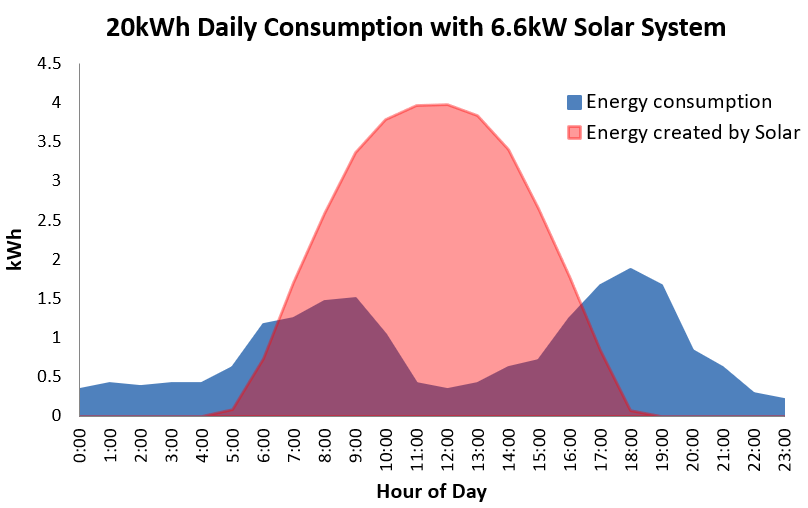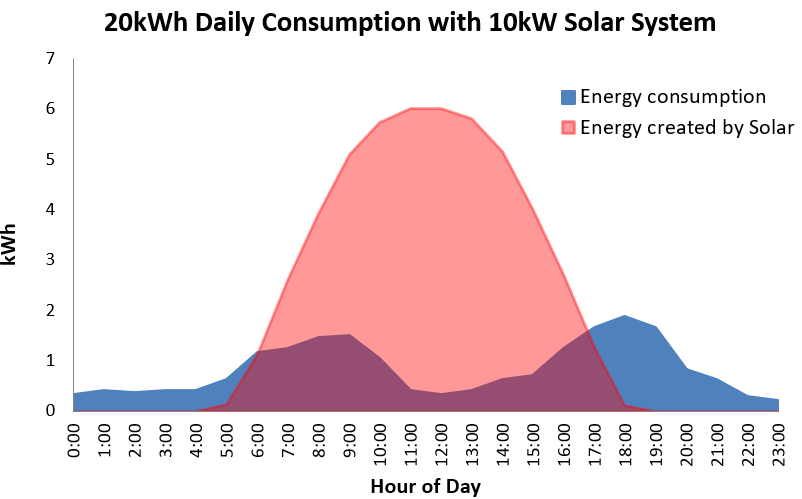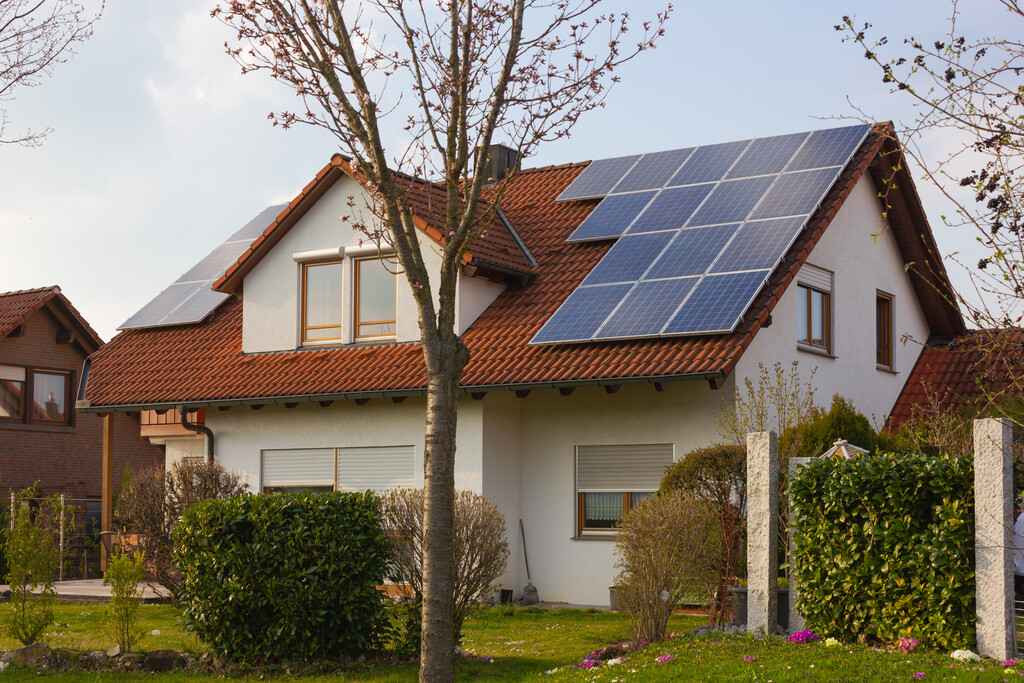Solar self-consumption is the key to maximising the return on your solar energy system. As feed-in tariffs continue to decrease across Australia, optimising how you use the solar energy produced by your panels has become more crucial than ever. With modern advancements in home energy management systems (HEMS), battery storage, and smart home technologies, it’s easier to make greater use of solar power that your system generates, lowering your electricity bills and reducing your reliance on the grid.
What is Solar Self Consumption?
When your solar panels produce energy, it’s used first to power your home. Any excess energy that isn’t used in real-time is sent back to the grid unless you have a battery storage system. Solar self consumption is a term used to describe the solar power that is used directly in the home and not exported back into the grid.
The Importance of Solar Self-Consumption
Solar self consumption has become increasingly important in recent years as the price that electricity retailers offer for buying back surplus energy (called a solar feed in tariff) has reduced significantly.
Self-consumed solar power will offset the rates you are buying electricity at which can be anywhere from 20 cents per kWh to 50 cents per kWh higher. Even the best feed in tariffs are only offering around 10 cents per kWh, but usually much less than this.
This means that to get the most financial return out of your solar power, you should try to use it when it is generated. Using a battery storage system to store power to use later is another method of increasing solar self-consumption but it is still a very expensive process.
Compare quotes from up to 7 installers in your area now.
Ways to Increase Solar Self-Consumption
There are various ways to increase your solar self-consumption. The impact of each method should be balanced against the efforts required and any costs involved which are summarised in our table below.
Shiftable Energy Loads
Taking some time to consider all the major appliances in your home and trying to either put them on a timer or adjust your habits to operate them in the middle of the day is one of the most effective ways of increasing self-consumption. Using your solar system’s monitoring portal you can check when you have the most solar power (usually between 9am and 3pm). Some of the most common options are:
- Hot Water Systems: Most electric hot water systems operate on a timer which can be adjusted to run in the middle of the day. This is often one of the biggest energy consumers in a household. If you don’t have an electric hot water system, consider upgrading to a hot water heat pump which is the most efficient way to heat your water
- Pool Pump: Pool pumps, for those lucky enough to have a swimming pool, are another big consumer of power. Usually your pool pump can be easily configured to run at certain times of the day or an electrician can put it on a time at your switchboard
- EV Chargers: As the number of EVs on the road increases year by year, this is becoming a more widely available way of increasing solar self-consumption. In fact many people install additional solar panels to cater to the
- Air Conditioning: Although it typically can’t be automated, focusing on running your air conditioning through the middle of the day can dramatically increase your solar self-consumption. Some air conditioners can be remotely activated before you get home to get your house to the desired temperature.
- Washing Machine & Dishwasher: The household appliances are the big ones when it comes to power usage. Both these devices now come with options to delay the commencement of a cycle so that you can run it at a preferred time of day. This might require some change in your daily habits!
- Smart Appliances: Many modern appliances come with scheduling features that allow you to set them to run during peak solar hours.
Battery Storage
For any loads that you can’t shift, solar batteries allow you to store excess solar energy generated during the day for use at night. Solar batteries come at a significant investment so whilst very effective, this is generally the most costly way of increasing your solar self-consumption.
There are also other benefits of solar batteries to be considered like providing power during a black out and participating in virtual power plants so they need to be considered in their own right. See our article that examines if solar batteries are worth it?
Size Your Solar System Appropriately
If you haven’t already installed solar then choosing a solar system that matches your household’s energy needs is crucial for maximising self-consumption.
Most solar professionals will be able to help you do this by analysing your energy bills, but be careful as they may have an incentive to sell you the biggest system they can. Our advanced solar calculator, will let you explore different load profiles and enter your average energy use to see how much solar would be self-consumed.
An appropriately sized solar system will closely match your current daytime energy requirements, but may also make allowance for future changes to your energy usage like buying an electric car or installing a solar battery.
Compare quotes from up to 7 installers in your area now.
Home Energy Management System
Home Energy Management Systems (HEMS) seek to monitor and control as many electric appliances within your home as possible. This gives you an accurate view of how much power each of your appliances draws and gives you some ability to remotely activate and manage their usage. Some of these systems can monitor your real-time solar production and dynamically adjust your appliances (like hot water and air conditioning) accordingly to maximise your self-consumption.
Solar self-consumption comparison matrix
| Initial effort required (shopping around for best deal) | Ongoing effort required | Effectiveness at maximising solar self-consumption | Potential for maximising savings | Cost | |
| Set up timers | Low | Medium to high (timers should be recalibrated seasonally) | Low to medium | Medium | Low |
| Hot water diverter | Medium | None | Medium to high | High | $700-$1500 |
| Home Energy Management System | Medium | Low to medium | Medium to high | High | $500-$1500 |
| Battery storage system | Medium to high (lots of options, big investment) | Low to none | High | High | $1,000-$2,500 per kWh of capacity |
Self Consumption Scenario: 3kW Solar System vs 5kW Solar System
If we represent it visually, solar self-consumption looks something like the graphs below. The blue areas represent household electricity consumption, while the red areas represent solar system energy production (in this case, a 6.6kW and a 10kW solar system). The red areas above the blue lines represent solar exported to the grid, while the blue on its own is energy being purchased/imported form the grid. The overlapping red/blue area is where the solar energy meets your home’s energy demand.

An example how home energy consumption and solar production from a 6.6kW solar system intersect during the day. The red area above the blue line represents exported solar energy.

The situation as above, but this time with a larger, 10kW solar system. The red area above the blue line represents exported solar energy.
The table below summarises in numbers the two charts above in terms of the percentage of self-consumed solar & system payback periods (along with some other useful figures).
| Example – home using 20kWh/day | 6.6kW @ $6,010 | 10kW @ $9,420 |
| Demand met by solar | 40% | 42% |
| % solar self-consumed | 30% | 22% |
| Payback period | ~4 years | ~5 years |
We can see that the larger system offers a marginally higher ability to meet the household demand by being able to produce more power in the early morning and evenings. The majority of power is exported back to the grid. With the assumption of a 5 cents per kWh feed in tariff this leads to a lower payback period of 5 years.
The history: Ghosts of solar feed-in tariffs past
Once upon a time in Australia there were state-based incentives for solar power generation called solar feed-in tariffs. These incentives rewarded solar homes for sending their solar energy into the grid at generous rates – frequently over 30 cents per unit of energy (kilowatt-hour, kWh). In contrast, these households may have only been paying 20c/kWh for electricity they purchased from the their electricity retailers. In these circumstances, it made sense to send solar into the grid, as this would deliver the biggest savings.
These days, pretty much anywhere you are in Australia the rate you will be paid for excess solar energy is generally very low (unless you are on a legacy feed-in tariff), regardless of whether there is a regulated minimum rate in your state or if the rate is a voluntary one set by your retailer. This means that if you’ve only just come into the solar game, you might be looking at your neighbour’s solar system wondering why they get 44c/kWh (to use a Queensland example), while the highest rates you can find are 4-10c/kWh.
It’s important to note that back then bigger bill savings were necessary for solar to make economic sense – solar systems were about 4x to 5x more expensive in 2010 than what they are now. So while we might look back with envy on ‘the good ol’ days’ when incentives were higher, the fact is that these days the solar value proposition is much closer to standing on its own proverbial legs, and as such the incentives are not needed to the same degree (although we certainly wouldn’t be complaining if they were still available). It does mean, however, that there are certain considerations you should make when choosing a system.
Compare quotes from up to 7 installers in your area now.
- The Top 5 Problems With Cheap Air Conditioning Quotes - 12 January, 2026
- APsystems Battery Review: An Independent Assessment by Solar Choice - 18 December, 2025
- Running Cost of Air Conditioners – Explained - 7 October, 2025

Hi, my name is Shay and I am really impressed by your solar calculator. I was exploring both the:
– Simple Solar PV System Sizing & Payback Estimator and
– Solar Choice Solar Power System Payback Calculator
Is there a way I can see the calculations behind the black box magic that you do? :)
Please let me know,
Thanks
Hi Shay,
Our calculators are our IP and have to remain the black boxes that they are to prevent them from being used by people who haven’t put in the effort that we have in making them. Happy to try to explain them a bit more if you like – shoot me an email on james@solarchoice.net.au.